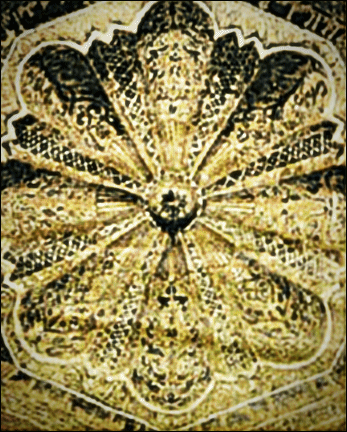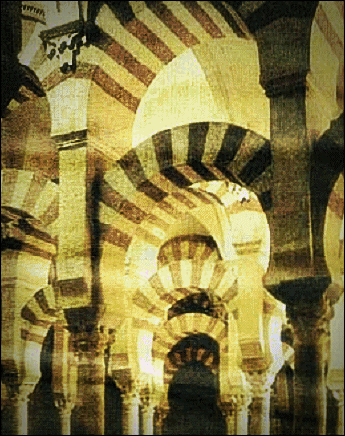Andalusia — the Golden Age’s shining example
Dato' Dzulkifli Abd Razak
Article
New Sunday Times - 07/24/2005
IT is fairly obvious that many of the practices of the culture of Andalusia are enshrined in the ideals and principles of Islam as emphasised in the Hadharic sense.
In fact, the Golden Age of Islamic civilisation is a direct outcome of it, without having to attach any religious label to it.

INTRICATE: Islamic artwork on the ceiling of the Cardoba mosque.
With Andalusia serving as the intellectual hub of the day, it was not strange that the 1979 Nobel Laureate of Physics, Abdus Salam, in his acceptance speech in Oslo, cited a specific case in Toledo as an example.
As early as the 11th century, Toledo had been a centre for the transmission of knowledge, culture and science to Europe.
Among the scholars who flocked to the place from all over Europe were Gerard of Cremona and John of Seville. Other famous translators were Peter Abelard of Bath, Robert of Chester, Stephenson of Saragossa, William of Lunis and Philip of Tripoli.
Gerard of Cremona, for example, went to Toledo to learn Arabic so that he could translate available Arabic works. He translated one of Ibn Sina’s seminal works on medicine into Latin. This became a major text for centuries in Europe.
This is in addition to more than 70 Arabic books on different subjects — ranging from basic works of the Greek to Arabic astronomical and mathematical works, to the surgical thesis of Al-Zahrawi (Albucasis).
Gerard stayed on in Toledo where he died in 1187.

SEEING STRIPES: Elegant arched dot the inside of the Cordoba mosque.
Salam, in his Nobel Laureate address, chose to focus on one Michael the Scot. His narration goes back to about 800 years ago, when the young Scotsman left his native glens to travel south to Toledo.
Michael wanted to live and work at the Arab universities of Toledo and Córdoba, where the great scholars such as Moses (Musa) bin Maimoun, and philosopher, physician, and commentator on Plato and Aristotle, Ibn Rushd (Averroes), had taught.
"Michael reached Toledo in 1217 AD. Once in Toledo, Michael formed the ambitious project of introducing Aristotle to Latin Europe, translating not from the original Greek, which he did not know, but from the Arabic translation by Averroes who then taught in Spain.
"From Toledo, Michael travelled to Sicily to the court of Emperor Frederick II.
"Visiting the medical school at Salerno, chartered by Frederick in 1231, Michael met Danish physician Henrik Harpestraeng, who was later to become court physician of King Erik Plovpenning.
"Henrik had come to Salerno to compose his treatise on blood-letting and surgery.
"Henrik’s sources were the medical canons of the great clinicians of Islam, Al-Razi and Avicenna (Ibn Sina), which only Michael the Scot could translate (from Arabic) for him.
"Toledo’s and Salerno’s schools, representing as they did the finest synthesis of Arabic, Greek, Latin and Hebrew scholarship, were some of the most memorable of international assays in scientific collaboration.
"To Toledo and Salerno came scholars not only from the rich countries of the east and the south, like Syria, Egypt, Iran and Afghanistan, but also from developing lands of the west and the north like Scotland and Scandinavia."
Complemented by the high level of religious tolerance and complete social freedom in Muslim Spain, a large number of Christian students from all parts of Europe flocked to it.
After completing their studies in Moorish schools and centres of learning, they went home and imparted their knowledge that they had acquired.
By then, the number of translators had flourished. Early translations were primarily into Latin and some into Hebrew.
Subsequent translations were done from Latin or Hebrew into the vernacular languages of Europe.
Thus, in the 12th and 13th centuries, medieval science was shaped by the recovery of classical and Islamic science, including the works of the Arabic commentaries, giving it the basis for continuing achievement in all fields of science.
These challenges to classical scientific ideas may have been a significant factor in the genesis of the Scientific Revolution of the 16th and 17th centuries, writes Elspeth Whitney in a book, Medieval Science and Technology (2004).
To this Salam pointed out: "Then, as now, there were obstacles to this international scientific concourse, with an economic and intellectual disparity between different parts of the world.
"Men like Michael the Scot and Henrik Harpestraeng were singularities. They did not represent any flourishing schools of research in their own countries."
Scholars are still unravelling the motivations and the conditions that led to this most creative movement of cultural transformation, but the evidence is clear enough.
It is nothing less than the intellectual vibrancy during the Andalusian period that sparked the change. It later lit up a new knowledge-based civilisation.
It is tempting to equate this situation to the immense resourcefulness and understanding the Muslims and Andalusians had, to adapt and transform the Hellenistic intellectual universe into a vital world view, reintegrating the classical world into a living culture.
As noted in the journal Interreligious Insight as recently as July last year, which focuses on dialogue among the world’s many faiths: "Al-Andalus was not a perfect society but it was arguably the pre-eminent Western society of its time inasmuch as it served as the link between the Greek and Roman civilisations before it and the European civilisation that was to follow.
"While the rest of Europe endured the Dark Ages, light and enlightenment shone brightly at times in al-Andalus."
Unmistakably, Andalusia had embraced Islam in the Hadhari sense, and it remains a shining example that needs to be understood, learnt and, more importantly, recreated in the spirit of civilisational Islam.
This is in line with what the Prime Minister said at the Islamic Academy of Sciences 2005 conference held in Kuala Lumpur in March: "I believe that the environment in Baghdad 800 years ago can serve as a powerful reminder of some aspects of Islam that have been neglected.
"Baghdad and the Islamic empire (notably Andalusia) became a thriving repository of knowledge, driven by a passion for and openness to learning."
That aptly sums up what Islam Hadhari, in action model on the Andalusian experience, is all about.
